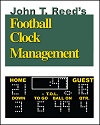Second edition of Football Clock Management released


John T. Reed Publishing News Release
342 Bryan Drive
Alamo, CA 94507
www.johntreed.com
FOR IMMEDIATE RELEASE Contact: John T. Reed 925-820-7262, johnreed@johntreed.com
Second edition of Football Clock Management released
Alamo, CA, May 14, 2001–“Clock management stinks at all levels of football, including the NFL,” says John T. Reed, author of the book Football Clock Management, now in its second edition. Reed’s book tells coaches how to manage the clock correctly—a relatively easy task that will increase the typical team’s number of wins by two or three per season.
Reed takes a unique approach for a coaching author. Football Clock Management is written like a law book, only in laymen’s terminology. First he sets for the rule. For example, Clock Management Rule 1.20 (b) says, “When in the slowdown tempo and the game clock is running: wait until the end of the play clock to (1) call for the snap or (2) call time out when you are on offense Exception: In the NFL, avoid calling time out between 2:39 and 2:00 left in the half.” Then Reed explains the logic behind the rule, which is analogous to legislative history in law books. Finally, he illustrates and proves the rule with actual cases from real games, analogous to published court decisions.
Reed selected a week of NFL play at random—Week 4 of the 1999 season—and analyzed the clock management of every game. Of the 14 games played that week, four were won by margins of more than eight points indicating that better clock management probably would not have changed the outcomes. But of the ten that were won by eight points or fewer, five would have had a different winner if the losers had managed the clock in accordance with the clock-management rules in Reed’s book.


That week, Kansas City, New Orleans, Oakland, Philadelphia, and Tampa Bay all lost because of clock-management mistakes. For example, Oakland failed to go to a slowdown in the first half when they should. Seattle scored with :59 left in that half and went on to win 22-21. Had Oakland done a proper slowdown, those :59 seconds, and that score, would never have happened and Oakland would have won.
A number of readers of the first edition commented that as a result of reading it, they would never watch a football game the same way again. They also said it had changed the way they viewed games they had seen in the past. CNN/SI’s “Dr. Z” (Paul Zimmerman) said “every NFL coach should take a look at this book.” Former Kentucky head football coach Hal Mumme said “Every coach should read this book.” Washington & Lee head football coach Frank Miriello called it “the best football coaching book I have ever read.”
Some of the subjects covered generate yawns, like spiking the ball, taking a safety, or taking a knee. Think again. Reed’s take-a-knee chapter tells of an NFL coach whose career ended less than 24 hours after he made a take-a-knee mistake; of an ESPN TV analyst who had to make a formal apology to a major college coach over a take-a-knee comment in a heartbreaker loss; of a high school all-star game lost because the quarterback took a knee one second too soon; of UNLV’s amazing 101-yard, game-winning touchdown run on what should have been a take-a-knee play by Baylor, of the Michigan player who gained the final first down his team needed to take a knee, but kept running instead of taking a knee on the fly, and was stripped of the ball, resulting in his team losing. Reed provides tables that show when college/high school (25-second play clock) and NFL (40 seconds) teams can take a knee. He advocates two new plays: the quarterback sweep-slide play, which is a much longer-duration take-a-knee play, and the fake take-a-knee, which makes sense in some end-of-first-half and end-of-tie-game situations.
Reed’s main complaint about football clock management is that coaches wait until the end of the half to do it. “You manage the clock starting with the first play of the game,” says Reed. “Coaches use probabilities all the time to decide what play or defense to call. But they cannot see that the same principle applies to clock management. If you’re probably going to be conserving time at the end of this game, why not start now? Every second you waste unnecessarily may be the one you need to win. If you are probably going to be in a slowdown at the end of this game, why not start now? Every second you leave on the clock unnecessarily may be the one your opponent uses to beat you. Football is not only a game of inches, it is also a game of seconds. Coaches have long fought for every inch, but not for every second. It has cost them many games and will continue to do so until they clean up their acts.”
The second edition is greatly improved over the first. For example, the take-a-knee table originally only showed the time the snap had to occur for the team to be in the take-a-knee period. The second edition tables show the time at the end of the play, referee's ready-to-play signal, and snap so coaches can ascertain what to do before the snap.


Football Clock Management tells when to take a knee, slow down, speed up, take a safety, spike the ball, fake spiking the ball, fake taking a knee, use a downfield lateral, decline a penalty, use time outs, and more. Although the first edition was sold in book stores nationwide, the second edition may only be purchased directly from the author.
Reed coached eleven seasons of youth and high school football and wrote the books, Coaching Youth Football, Coaching Youth Flag Football, Gap-Air-Mirror Defense for youth Football, and Coaching Youth Football Defense. He is a West Point graduate and a Harvard MBA.